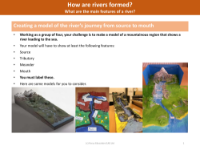What are the main features of a river? - Presentation

The study of rivers encompasses various aspects, from their formation to the geographical features and the reasons why they are vital to human settlements. Rivers begin at a source, often in highland areas, and flow towards the sea, ending at an estuary. Along their journey, rivers exhibit distinct characteristics in their upper, middle, and lower courses. Key features include tributaries, where smaller streams merge into larger ones, meanders which are the winding curves of a river, and the processes of river erosion and deposition. Erosion shapes the riverbanks and channels, while deposition occurs when materials eroded upstream are laid down elsewhere, often forming new land features. Understanding these concepts is part of the National Curriculum for Key Stage 2, which also emphasizes the importance of knowing the names and locations of significant rivers both in the UK and globally.
Geographical skills and fieldwork are integral to comprehending river systems, with students encouraged to use maps and digital tools like Google Earth to trace the courses of local and famous rivers. Hands-on activities such as model-making and local river surveys help solidify the theoretical knowledge. These models illustrate various river features, such as sources, tributaries, meanders, and mouths. Through experimentation, students learn about the natural forces of erosion and deposition, observing how water interacts with soil and rocks to shape the river's landscape. By exploring these features and processes, students gain a deeper appreciation of how rivers are formed and the role they play in shaping our environment and supporting human life.





